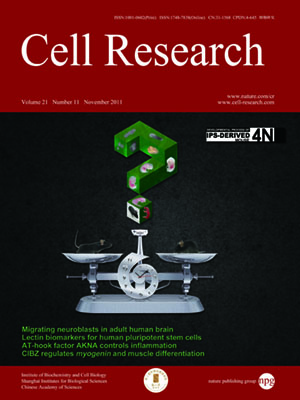
Volume 21, No 11, Nov 2011
ISSN: 1001-0602
EISSN: 1748-7838 2018
impact factor 17.848*
(Clarivate Analytics, 2019)
Volume 21 Issue 11, November 2011: 1534-1550
ORIGINAL ARTICLES
Identification and characterization of neuroblasts in the subventricular zone and rostral migratory stream of the adult human brain
Congmin Wang1, Fang Liu1, Ying-Ying Liu2, Cai-Hong Zhao2, Yan You1, Lei Wang3, Jingxiao Zhang4, Bin Wei1, Tong Ma1, Qiangqiang Zhang1, Yue Zhang1<
1Institutes of Brain Science and State Key Laboratory of Medical Neurobiology, Fudan University, 138 Yixueyuan Road, Shanghai 200032, China
2Institute of Neurosciences, The Fourth Military Medical University, Xi'an 710032, China
3Department of Human Anatomy, Hebei Medical University, Shijiazhuang 050017, China
4Department of Obstetrics and Gynecology, The Fourth Hospital of Shijiazhuang, Shijiazhuang 050011, China
5Institute for Cell Engineering, Department of Neurology, Johns Hopkins University School of Medicine, Baltimore, MD 21205, USA
Correspondence: Zhengang Yang,(yangz@fudan.edu.cn)
It is of great interest to identify new neurons in the adult human brain, but the persistence of neurogenesis in the subventricular zone (SVZ) and the existence of the rostral migratory stream (RMS)-like pathway in the adult human forebrain remain highly controversial. In the present study, we have described the general configuration of the RMS in adult monkey, fetal human and adult human brains. We provide evidence that neuroblasts exist continuously in the anterior ventral SVZ and RMS of the adult human brain. The neuroblasts appear singly or in pairs without forming chains; they exhibit migratory morphologies and co-express the immature neuronal markers doublecortin, polysialylated neural cell adhesion molecule and 逫II-tubulin. Few of these neuroblasts appear to be actively proliferating in the anterior ventral SVZ but none in the RMS, indicating that neuroblasts distributed along the RMS are most likely derived from the ventral SVZ. Interestingly, no neuroblasts are found in the adult human olfactory bulb. Taken together, our data suggest that the SVZ maintains the ability to produce neuroblasts in the adult human brain.
Cell Research (2011) 21:1534-1550. doi:10.1038/cr.2011.83; published online 17 May 2011
FULL TEXT | PDF
Browse 1959


